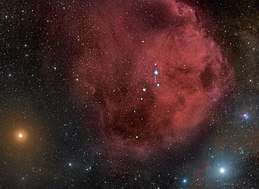HD 34989
| Observation data Epoch J2000.0 Equinox J2000.0 | |
|---|---|
| Constellation | Orion |
| Right ascension | 05h 21m 43.5603s |
| Declination | +08° 25′ 42.802″ |
| Apparent magnitude (V) | +5.78 |
| Characteristics | |
| Spectral type | B1V C |
| U−B color index | ? / ? |
| B−V color index | ? / ? |
| Variable type | none / ? |
| Astrometry | |
| Radial velocity (Rv) | +26 ± 5 km/s |
| Proper motion (μ) | RA: -2.20 ± 0.94 mas/yr Dec.: -2.97 ± 0.50 mas/yr |
| Parallax (π) | 4.43 ± 0.83 mas |
| Distance | approx. 700 ly (approx. 230 pc) |
| Absolute magnitude (MV) | -0.99 |
| Details | |
| Metallicity | 37% of the sun's |
| Other designations | |
HIP 25041, HD 34989, PMC 90-93 1242, uvby98 100034989, AG +08 591, HIC 25041, PPM 148818, VDB 38, ALS 8286, HR 1763, ROT 774, WH 21, BD +08 933, IRAS 05190+0822, SAO 112667, YZ 8 2140, FK5 2401, JP11 1038, [KSP2003] G194.6241-15.6072, GC 6574, LS VI +08 1, TD1 4461, [KSP2003] J052143.58+082543.0, GCRV 3206, 2MASS J05214355+0825425, TYC 700-1015-1, [M26] 1, MCW 299, UBV 5096, [SC93b] 146, GSC 00700-01015, N30 1147, UBV M 10870 | |
| Database references | |
| SIMBAD | data |
HD 34989 is a blue-white star in the main sequence, of apparent magnitude 5.78, in the constellation of Orion. It is 736 light-years from the solar system.
Observation

The star is in the northern celestial hemisphere, but close to the celestial equator; this means that it can be observed from all the inhabited regions of the Earth without difficulty and that it is not visible only in the innermost areas of Antarctica. It appears as circumpolar only far beyond the Arctic polar circle. Its brightness puts it at the limit of visibility to the naked eye, so to be observed without the aid of devices requires a clear, and preferably moonless, sky.
The best period for observation in the evening sky is between late October and April from both hemispheres; in February (as at J2000) it is anti-posed from the sun. In July and August its direction is close to that of the sun, therefore coinciding with most hours of daylight.
Physical characteristics
It is a blue-white star of the main sequence, having an absolute magnitude of -0.99 and its positive radial velocity indicates that the star is moving away from the solar system. The star appears wrapped in an extensive nebulosity that partly shines by reflection and partly by emission; this cloud is listed as vdB 38.
